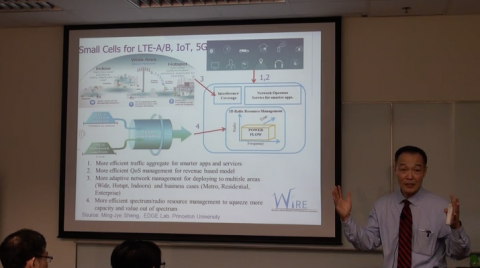
Right after iPhone was released on June 29, 2007, Steve Jobs’ Un-equilibrium Relationship occurs immediately (i.e. Create a fascinating market gap of “Demands >> Supply” scenario for consumers) and then affect the “Quality of Services” seriously for many wireless operators ultimately. Now the number of wireless subscribers who use smart phones for video streaming applications and high-speed wireless data usage keeps increasing every day. It has been estimated that the traffic volumes will be increased by at least 1000X from 2010 to 2020. The requirement for energy consumptions will also be sharply increased accordingly. Although more and more wireless operators are now starting to deploy the wireless 4G-LTE systems around the globe, but it is clear that the current technologies could not fulfill many of the demanded emerging services, the new type of social media-enabled traffic pattern, and specifically the anticipated data storm ahead of us. It is now the right time for scientists, engineers, technologists, manufacturers and telecom policy makers to get together to have brainstorm on the network architecture, features, functional requirements, business models and international standards for the future Wireless 5G and wired-wireless convergence networks in order to meet the anticipated demands in our future daily life.
Based on the speaker’s expertise and experiences in wireless technologies and networking systems, this talk will first describe the reasons WHY we need to have “ wireless 5G” initiated now, HOW we pursuit it and WHAT will be the final results which we could anticipate to have. A few proposed features (such as small cell networks, smart data pricing and SDN-based mobility management) with promising emerging services (IoV) for wireless 5G will be addressed and discussed in this talk.
T. Russell Hsing is now Visiting Chair Professor of National Chiao Tung University in Taiwan, Guest Professor of Peking University in China, Adjunct Professors for Arizona State University (US), Yonsei University (Korea), and Chinese University of Hong Kong. He is also Advisor for the Next Generation Mobile Networks (NGMN) Alliance in Europe. He is now also a member of the Advisory Board for the EDGE Lab. of Princeton University and the DataMi, Inc., a start-up to develop smart date pricing solutions for Broadband Data, in Princeton, US. He has been co-Editor-in-Chief (with Prof. Vincent Lau of HKUST) of the ICT Book Series for the John Wiley & Sons since 2007. He was Founding Chair of the Vehicular Network and Telematics Applications sub-Technical Committee for the IEEE Communications Society. He has been serving as member of the IEEE Fellow Committee in 2012-2014, the member for the IEEE Eric Sumner Award Committee since 2011. He is now Vice Chair for the IEEE Technical Field Award Council in 2014. His current research areas are: Wireless 5G, Internet of Vehicles (IoV), Software Defined Networks-based Mobility Management, and Technology Ventures in Academic Community.
From September to December in 2012, he was Visiting Professor at POSTECH (under the World Class University Program) in Korea. From March, 1986 to March, 2012, he has been with Bellcore (and then Telcordia Technologies & Ericsson) as Executive Director to manage and lead the Emerging Technologies and Services R & D Department. He was also responsible for the Telcordia Applied Research Center in Poland (2008-2012), and in Taiwan (2005- 2012).He had been working with Burroughs, Xerox, GTE Labs and Telco System Fiber Optics Corporation and TASC from February, 1977 through March, 1986. His background and working experiences are in the areas of video communications & image processing, CCD sensors, VLSI systems, ADSL/HDSL, wireless technologies and networking systems and vehicular networks and telematics applications. He graduated from the National Chiao Tung University (Taiwan) in 1970, and received his M.S. and Ph.D from the Electrical Engineering Department of the University of Rhode Island in 1974, and 1977. He has finished Executive mini-MBA Courses from the Stanford Business Graduate School, MIT Sloan School, and the University of Texas at Austin from 1995 through 2002. He is Fellow of the IEEE, the British Computer Society (BCS) in UK, and the SPIE-The Internal Society for Optical Engineering. He has been Co-Editor-in-Chief (with Prof. Vincent K. N. Lau of HKUST) of the ICT Book Series for the John Wiley & Sons Inc. since 2007.
